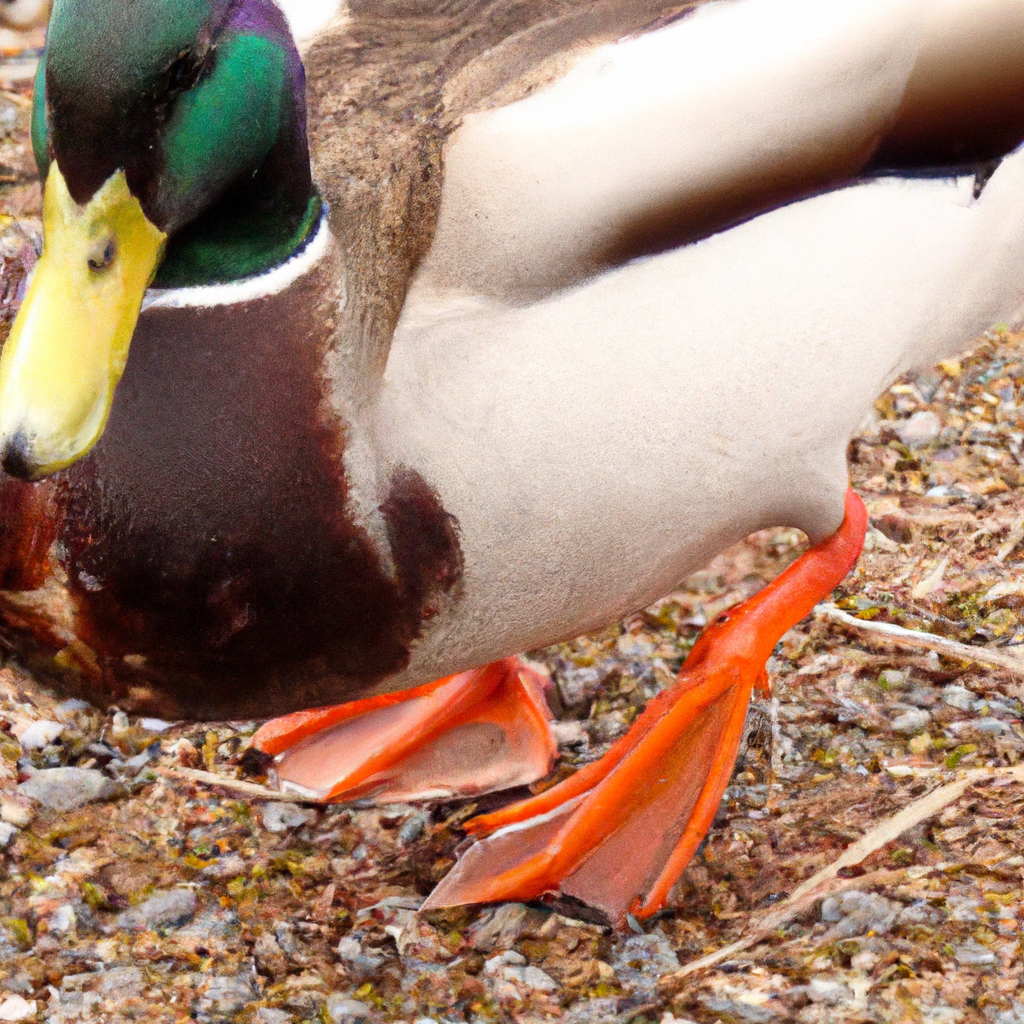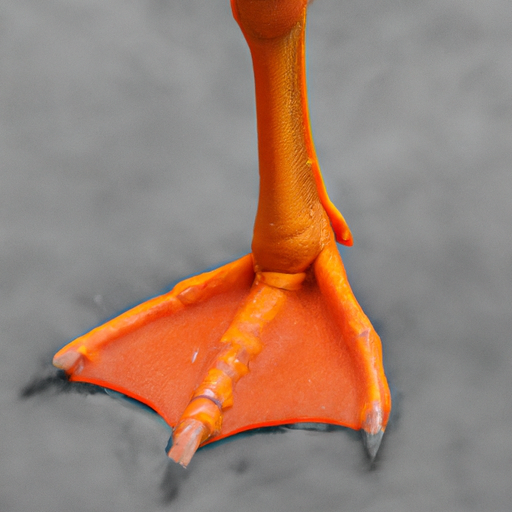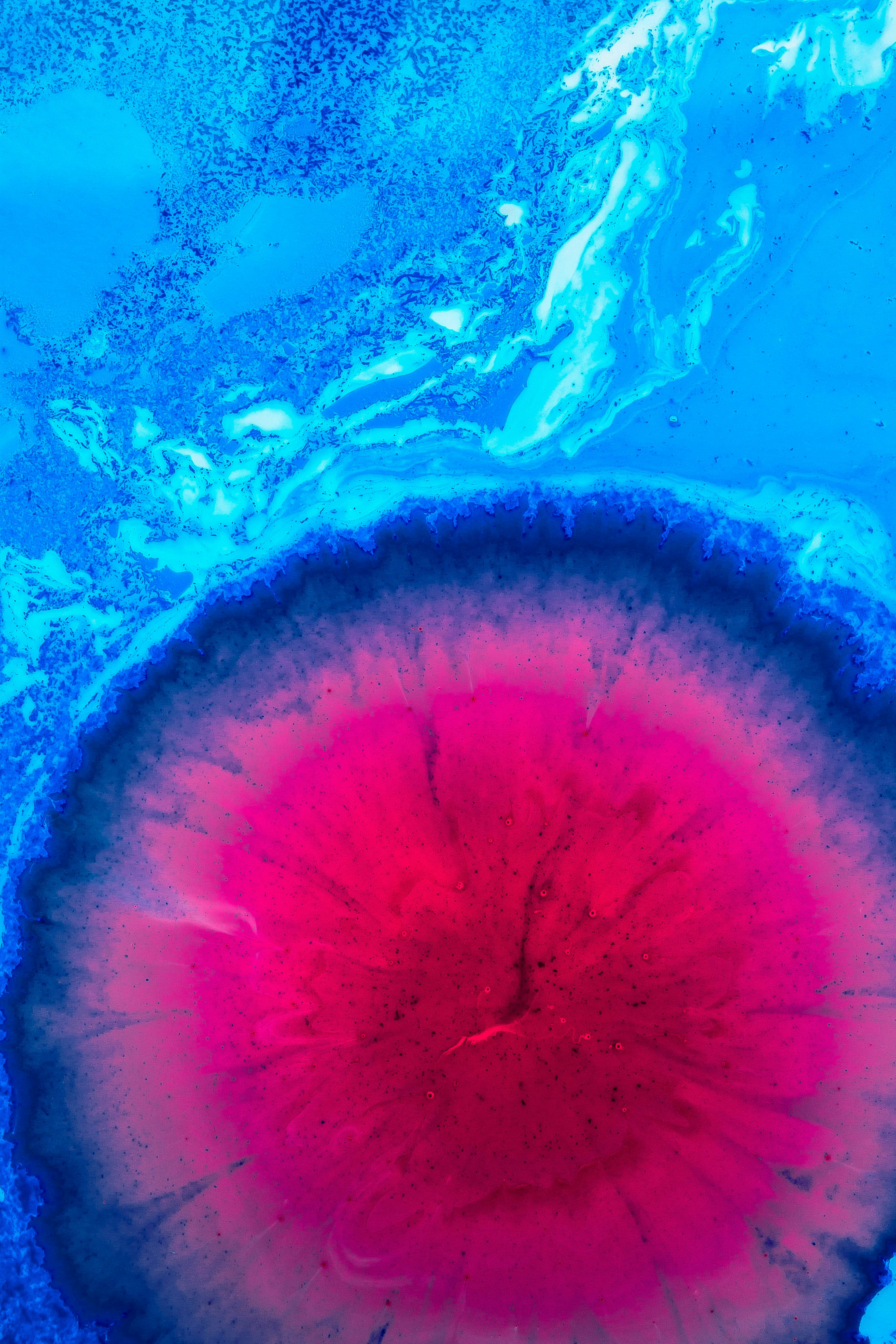In the fascinating world of nature, ducks captivate us with their distinctive features. One such puzzling trait is the presence of vibrant orange feet. Have you ever wondered why ducks possess this eye-catching characteristic? The answer lies in a peculiar blend of biology and evolution, rooted in the survival strategies that these waterfowls have honed over time. This article unravels the intriguing mystery behind why ducks have orange feet, shedding light on the remarkable adaptability of these feathered creatures.
Evolutionary Adaptation
Background
Evolutionary adaptation refers to the process by which a species gradually develops certain traits or characteristics over generations to maximize its survival and reproduction in a specific environment. These adaptations can be physical, physiological, or behavioral and play a crucial role in the overall fitness of a species. One intriguing example of an adaptation is the presence of orange feet in ducks.
Purpose of Orange Feet
The purpose of orange feet in ducks is multi-faceted and serves various functions that aid in their survival and reproductive success. The vibrant orange coloration of the feet is not a random occurrence but rather a result of natural selection favoring individuals with this trait. Let us delve into the different roles that orange feet play in the life of ducks.
Role of Pigmentation
The high pigmentation levels in the orange feet of ducks serve as a visual signal to communicate various important aspects. One primary role of this pigmentation is mate attraction and selection. Bright-colored traits are often associated with good health and genetic quality, and ducks with vivid orange feet are more likely to attract potential mates. The intensity of orange pigmentation may indicate superiority, indicating a better potential partner for reproduction.
The Attraction Factor
Moreover, orange feet enhance the overall visual attractiveness of ducks. In a social context, ducks with brightly colored feet may capture the attention and interest of their flock mates. This can promote social bonding, cooperative behavior, and establish a stable social hierarchy within the group. By having eye-catching feet, ducks can also stand out against their environment, making it easier for their group members to locate them.
Feeding Behavior
Foraging Strategies
Ducks are opportunistic feeders and employ various foraging strategies to obtain food. Their diets consist of a wide range of items such as aquatic plants, insects, small fish, and crustaceans. When foraging, ducks often employ dabbling behavior, upending their bodies and immersing their heads underwater while their orange feet remain above the water. This strategy allows them to reach food sources beneath the water’s surface.
Feet Color and Food Availability
Orange feet in ducks have a clear connection to feeding behavior. The bright coloration of their feet serves as a visual cue, signaling food availability to other ducks. When ducks spot a potential food source, they often use their orange feet to communicate this information to their flock mates. The vibrant color acts as a beacon, indicating an area rich in food resources, thus facilitating group feeding and maximizing foraging efficiency.
Visual Signals for Group Feeding
The orange color of their feet not only aids in individual feeding but also plays a crucial role in synchronizing group feeding behavior. When large flocks of ducks gather, especially in shallow water or wetlands, the collective presence of orange feet becomes a powerful visual signal. By observing the orange feet of other ducks, individuals in the group can discern feeding patterns and adjust their behavior accordingly. This synchrony helps avoid unnecessary competition and ensures optimal resource utilization.
Environmental Factors
Natural Camouflage
In the animal kingdom, camouflage is a widespread adaptation for survival. However, it may seem counterintuitive for ducks to possess bright orange feet if they need to remain inconspicuous. Interestingly, the coloration of orange feet serves as a form of natural camouflage for ducks in their natural habitats. When swimming or wading in the water, the orange color blends with the surrounding vegetation, making it more challenging for potential predators, such as birds of prey or mammals, to detect them.
Habitat Selection
Ducks prefer habitats with abundant vegetation, such as wetlands, marshes, and ponds. These environments provide ample food sources, nesting sites, and protection for rearing offspring. By having orange feet, ducks can effectively select suitable habitats that offer optimal camouflage. The coloration enables them to blend in seamlessly with the environment, enhancing their chances of evading predators and successfully reproducing.
Feet Protection
Another advantage of orange feet in ducks is their role in foot protection. Ducks spend a significant amount of time in wet environments, which can expose their feet to potential dangers. The vibrant orange coloration acts as a warning signal, deterring parasites or pathogens from approaching the feet. Furthermore, the tough and rough skin of their feet, coupled with the pigmentation, provides an added layer of protection against abrasions and infections.
Mating Rituals
Courtship Displays
The mating rituals of ducks are often elaborate and involve extravagant displays to attract and court potential mates. Orange feet play a crucial role in these courtship displays. Male ducks flaunt their vibrantly colored feet while engaging in intricate dances and movements to capture the attention of females. The bright orange hue serves as an indicator of the male’s physical condition, genetic fitness, and overall reproductive potential.
Color Signaling in Mate Selection
The presence of orange feet in male ducks is an important factor in mate selection for females. It indicates the male’s ability to acquire sufficient resources, as bright pigmentation is often associated with good health and strong genetics. Females are more likely to choose males with vibrant orange feet, as this trait suggests higher chances of successful reproduction and the potential transmission of advantageous genes to their offspring.
Fertility Indication
Orange feet in ducks can also provide valuable information about the female’s fertility status. When a female duck is in her reproductive phase, her feet often display a more intense and vibrant orange color. This color change acts as a visual cue to males, indicating the female’s readiness to mate. The brighter the orange hue, the higher the female’s fertility, enabling potential mates to direct their reproductive efforts effectively.
Communication
Visual Communication
Ducks employ various visual signals to communicate with members of their species. These signals are particularly important for establishing social hierarchies, maintaining group cohesion, and facilitating reproductive interactions. The distinct orange coloration of their feet serves as a prominent visual signal for communication purposes. Ducks can display their orange feet to convey aggression, submission, territorial boundaries, and other important messages to their flock mates.
Social Hierarchy
Within duck flocks, a social hierarchy often develops, determining dominance and access to resources. The coloration of their feet contributes to the establishment and maintenance of this hierarchy. Ducks with more vibrant orange feet are generally perceived as higher-ranking individuals and may assert dominance over others. The visual prominence of their feet signals their strength, genetic fitness, and ability to secure resources, ensuring their higher status within the group.
Parental Care and Bonding
Orange feet also play a role in parental care and bonding between ducks. Both male and female ducks exhibit strong parental instincts and contribute to the rearing of their offspring. The presence of orange feet helps enhance recognition between parents and their young ones. Ducklings can identify and bond with their parents by associating the distinct coloration of their feet with the nurturing and protection they provide. This visual cue strengthens the familial bond and promotes successful parental care.
Temperature Regulation
Heat Absorption and Radiation
Temperature regulation is vital for the survival of ducks, especially in environments with fluctuating temperatures. The orange coloration of their feet plays a role in this process. The dark pigmentation absorbs heat energy from sunlight, helping to warm the ducks’ bodies in cooler conditions. Conversely, when exposed to high temperatures, the feet radiate excess heat, preventing overheating and aiding in maintaining an optimal body temperature.
Behavioral Thermoregulation
Ducks exhibit behavioral thermoregulation techniques to regulate their body temperature. One such behavior involves spreading their wings and exposing their orange feet to the sun. By doing so, they maximize heat absorption, particularly in cooler climates. This behavior allows ducks to increase their body temperature, ensuring that they remain warm and active, even in cold environments.
Feet Blood Vessels and Heat Dissipation
The blood vessels within the feet of ducks also contribute to temperature regulation. The vascular system in the feet acts as a thermal regulatory mechanism. When ducks need to cool down, the blood vessels dilate, allowing increased blood flow to the feet. This promotes heat dissipation, as the warm blood comes into contact with the surrounding air or water, effectively releasing excess heat and helping to regulate body temperature.
This image is property of images.unsplash.com.
Health Indicators
The Role of Carotenoids
Carotenoids are organic pigments found in various plants and animals, including ducks. These pigments contribute to the vibrant orange coloration of their feet. Carotenoids play a vital role in the overall health and immune system of ducks. They act as antioxidants, reducing oxidative stress and enhancing immune function. Ducks obtain carotenoids through their diet, particularly from consuming certain plant materials, and these pigments are then deposited in their tissues, including their feet.
Feet Color and Immunity
The presence of orange feet in ducks serves as an indicator of their immune system’s strength and overall health. The intensity of the orange coloration can reflect the individual’s ability to obtain an adequate supply of carotenoids and thus signifies its immune competence. By selecting mates with bright orange feet, ducks increase the chances of producing offspring with robust immune systems and higher resistance to diseases and infections.
Disease and Infection Detection
The coloration of their feet can also help ducks detect potential diseases or infections in themselves or other flock members. Any color abnormalities or changes in pigmentation can indicate health issues or stress. Ducks may pay close attention to the condition of each other’s feet, as these visual signals provide valuable information about the general well-being of the flock. Early detection enables them to take appropriate measures to prevent the spread of diseases and maintain a healthy population.
Species Variation
Ecological Niche Differentiation
Different species of ducks may display variation in the coloration of their feet due to their specific ecological niches and habitats. While many duck species exhibit vibrant orange feet, some species may have feet ranging from yellow to red or even dull brown. This variation allows ducks to adapt to various habitats and blend in with their surroundings more effectively. The feet coloration is an adaptation that matches their specific ecological requirements and increases their chances of survival.
Hybridization and Variation
Hybridization, the interbreeding of different duck species, can lead to further variation in feet coloration. When different species with distinctive feet color traits come into contact and reproduce, the resulting offspring may exhibit a combination of traits from each parent species. This variation in feet coloration can provide insights into the genetic diversity within duck populations and their evolutionary history.
Geographical Influences
Geographical factors, such as the availability of specific food sources or particular environmental conditions, can also influence feet coloration in ducks. Different regions may have different plant species rich in carotenoids, leading to variations in the availability and uptake of these pigments. Ducks inhabiting areas abundant in carotenoid-rich food sources may exhibit more intense orange feet, while those in areas with limited carotenoid availability may have relatively paler or less conspicuous feet.

Predator Awareness
Warning Signals
Having brightly colored feet can serve as a warning signal to potential predators. The vibrant orange hue acts as a visual deterrent, advertising the potential danger associated with hunting or preying on ducks. Predators may associate the bright color with an unpleasant or noxious taste from plants or invertebrates that ducks consume, thereby conditioning them to avoid hunting individuals with such prominent feet.
Predator Recognition
In addition to discouraging predators, the coloration of ducks’ feet also aids in predator recognition. Ducks, especially those living in habitats with limited visibility, rely on visual cues to identify potential threats. By having distinctive orange feet, ducks can more easily recognize members of their own species and differentiate them from potential predators, minimizing the risk of misguided aggression or attack.
Feet Color and Escape Strategies
When threatened, ducks employ various escape strategies to evade predators. The coloration of their orange feet plays a crucial role in these strategies. Ducks may display their feet prominently as part of their escape behavior, diverting the predator’s attention away from more vulnerable body parts. The striking color can act as a decoy, distracting the predator from capturing vital organs and increasing the chances of survival for the duck.
Conservation Implications
Threats to Duck Populations
Understanding the various adaptations, including the presence of orange feet, is crucial for conservation efforts concerning duck populations. Ducks face numerous threats, such as habitat loss, pollution, climate change, and hunting. By comprehending the significance of orange feet and how it contributes to survival and reproductive success, conservationists can better assess the impact of these threats on duck populations and prioritize conservation strategies accordingly.
Indicator of Wetland Health
Wetland ecosystems play a vital role in the survival of ducks and numerous other species. The presence of ducks with vibrant orange feet can serve as an indicator of wetland health. Ducks are highly dependent on wetlands for food, nesting, and rearing their young. By monitoring the population and behavior of ducks with orange feet, researchers and conservationists can evaluate the overall health of wetland ecosystems and take necessary measures to preserve these crucial habitats.
Conservation Management Strategies
The presence of orange feet in ducks can guide conservation management strategies for their protection. This unique adaptation should be taken into account when developing conservation plans, ensuring that habitats rich in resources and suitable for foraging are preserved and restored. Strategies should also focus on minimizing the impact of predators and maximizing awareness of the threats faced by ducks, thereby promoting sustainable populations and healthy ecosystems.
In conclusion, the presence of orange feet in ducks is a remarkable example of evolutionary adaptation. These vividly colored feet serve multiple purposes, including mate attraction, group communication, camouflage, thermoregulation, health indicator, and predator awareness. Understanding the significance of orange feet aids in appreciating the complex interactions between ducks and their environment. By recognizing the importance of this unique adaptation, we can better protect and conserve duck populations and their habitats for future generations.


